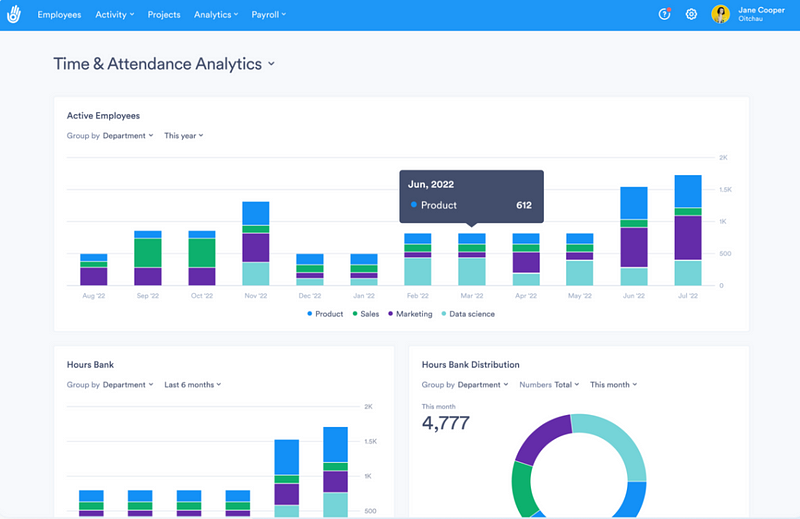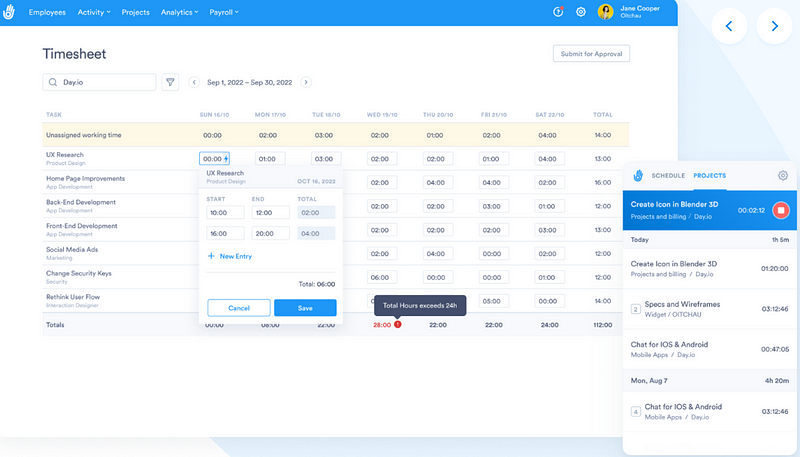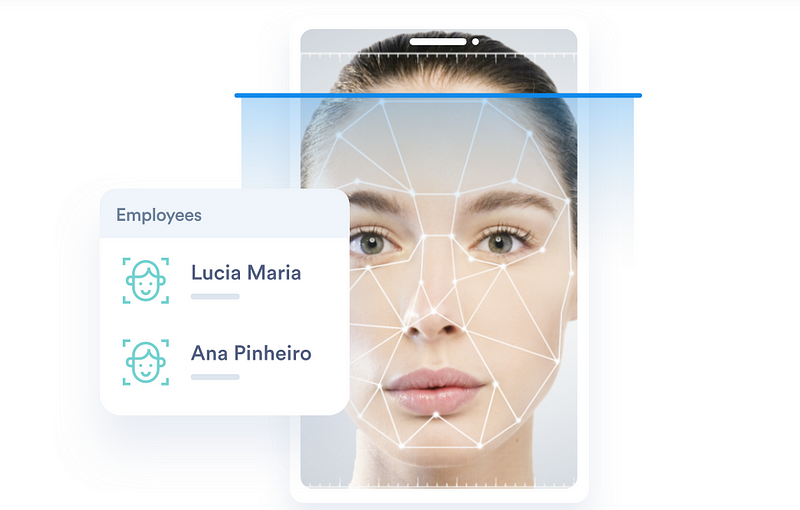Accurate time tracking is essential to achieve optimal business performance. Whether it’s for improving productivity, reducing costs or increasing profits – the impact of effective time tracking cannot be understated.
To ensure your system is up to speed with the latest best practices, here are 16 top tips for successful time tracking in 2023.

16 Time Tracking Best Practices
Time tracking may seem straightforward, but it can cause plenty of issues when done improperly. What’s the best way to do it? Read on for tips & tricks from one of the top time tracking companies on the globe.
1. Start with a transparent time tracking app
First, find a time tracking app that offers transparency, user-friendliness and detailed reports. Make sure to take the time to ensure your team is comfortable with all of the features of whatever app you end up choosing – communication is key.
Day.io, for instance, provides comprehensive time tracking features that offer complete visibility into your team’s performance, making the process more transparent than ever.

2. Develop a strict tracking methodology
Finding the best time-tracking methodology for your organization is essential. Every company is different, but consider factors such as deadlines, completion dates, milestones and any other relevant information to ensure you select an approach that works for you.
Some companies track time based on project, activity, task or client. Make sure it fits with your organizational needs, and then stick to it!
3. Start with a test case first
For a successful implementation of the time tracking system, it is essential to begin with a test case. This will give you an understanding of how the system works and if its capabilities fit your business requirements.
To assess data accuracy, try tracking several tasks in detail. Failing to do so could lead to wasting valuable resources if the system does not meet your organization’s expectations.
4. Set measurable goals and objectives
When it comes to tracking time, you must set tangible objectives that can be measured accurately. This will enable you to evaluate your team’s progress and track their performance.
For example, a goal could be to reduce costs by 5% in the next quarter or increase profits by 10%. Having measurable goals enables better decision-making when it comes to selecting a time tracking system — modern apps like Day.io integrate effortlessly with budgeting tools and other project management software for this purpose.
5. Set a “leave schedule”
When overseeing a project with a tight deadline, it is essential to factor in the leave schedules of your team members. This will help you effectively plan out the project and ensure that all tasks are finished on time.
Utilize an employee leave calendar through your time tracking system to keep everyone in the team organized and aware of their work schedules. Doing so guarantees timely completion of each task.
6. Do not overemphasize monitoring
Monitoring your team’s performance is essential, but it should not be done excessively. You can set reasonable expectations and ensure the time tracking system does not become overly intrusive. Several research findings have identified that too much monitoring can hurt the morale of your team members.
Ensure that your time tracking system is efficient for your team and they are comfortable using it. Leverage communication channels such as Slack to stay connected with them and provide feedback.
7. Use both automated and manual entry system
If you’re looking for an efficient and accurate way to track time, combined automated and manual entry systems are the best solution. Automated time tracking utilizes conditional automation, turning on when certain conditions are met.
Although there are times where manual entry is necessary, using both automated and manual tracking ensures optimal efficiency. The latter lets you handle edge cases. For instance , if you have complex tasks or multi-year projects to track, manual entry probably makes more sense.
Good news: Day.io has both manual and automated time tracking built-in from day one.
8. Choose an app that comes with a native timesheet feature
Your time tracker might include a timesheet feature to help you accurately track the work of your team members. Timesheets give you a live overview of how much time each person is spending on their tasks, making it significantly easier for managers to analyze data and make better decisions on short notice.
If you have to create manual timesheet entries by exporting the project data to Excel, CSV, or other formats, it can create extra work and consume more time. Day.io, for instance, natively allows you to create highly customizable timesheets with the tracked data in real time.

9. Use anti fraud features
Most time tracking systems are equipped with anti-fraud features to help detect any fraudulent activities. Implementing these measures, such as user authentication, IP address detection and access control, are essential in securing your data and preventing unauthorized access.
For instance, Day.io offers enhanced verification methods like GPS authentication which requires users to be in a specified location while tracking their time. This feature is especially beneficial for salespeople or other mobile employees who work away from the office.
10. Include non billable hours in your tracking data
You may be tempted to only track billable hours, but it is essential that you also include non-billable hours in your data. From planning and research to training, this information will prove invaluable when making decisions related to resource allocation and productivity optimization. Project managers and HR departments alike can benefit from tracking non-billable hours for valuable insights.
11. Automated Time Clock
An automated time clock is a great way to keep track of the working hours of your team members. It can also help you monitor their attendance and productivity levels.
Automated clock-in, clock-out apps like Day.io are perfect for small businesses that need an easy-to-use solution. This app allows you to track time for multiple projects with just a few clicks. Day.io lets your employees activate the time clock by facial recognition or voice commands, and get the data automatically synced with the online app.

12. Don’t forget to track attendance
For many industries, tracking attendance alongside time can provide invaluable insight into employee hours and whereabouts.
Biometric scanners or computerized systems are great tools to ensure accurate attendance tracking – Day.io even allows you to configure your own tolerance limits for late entries and early exits.
13. Track activity levels too!
Time tracking data may not give you the full picture of your team’s performance. Therefore, you should track activity levels as well. This will help you understand how long each task took and how productive your team was in completing it.
Your time tracking app may track activities in several ways, such as:
- Taking screenshots
- Recording video or picture using the webcam
- Using tracking widgets
- Monitoring user activity and desktop usage based on keyboard and mouse strokes
If you spot any unusual activity, act fast and identify the issue. You may also want to reach out to the concerned team member. Though there are many apps for tracking activity, take care not to store sensitive data such as passwords or other confidential information in keystrokes.
14. Spend time for task categorization
Task categorization is essential when you begin time tracking. Although it may seem unnecessary for small projects, as your business grows, correct categorization will provide invaluable insights into team performance and help you effectively allocate resources. Day.io allows for effective management of multiple projects and tasks per client, making task categorization easier than ever.
15. Make use of integrated budgeting features
Maximise the accuracy of your project budgeting with integrated budgeting features in your time tracking system. Set a budget for each task or activity and track it in real-time to ensure no unexpected costs.
Day.io can help you stay on top of invoicing, automatically generating them for clients ensuring complete accuracy every time.
16. Configure real time notifications
One of the core use cases of most time tracking apps is real-time alerting. These notifications can be configured in the app, letting you know when any task or project is completed and when deadlines are approaching. This will ensure that your team remains on track and meets its targets within specified timelines.
Day.io provides real-time notifications for various purposes, such as:
- Anomalies with the estimated time and actual time taken
- Extra hours worked
- Attendance data beyond the tolerance limit

Wrap-Up: Follow Time Tracking Best Practices with Day.io
Time tracking is a must for today’s organizations, as it boosts team performance, cuts costs, and increases profits. Follow these 16 time tracking best practices to get the most out of your system.
Day.io offers an extensive selection of features that make time tracking more efficient than ever before. With its transparency and real-time notifications feature, you can ensure your organization runs like clockwork in 2023. Sign up now on Day.io to start putting these best practices into practice!
